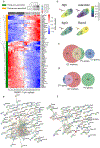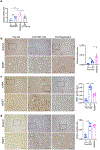Heterogeneity of HSCs in a Mouse Model of NASH
- PMID: 33550587
- PMCID: PMC8346581
- DOI: 10.1002/hep.31743
Heterogeneity of HSCs in a Mouse Model of NASH
Abstract
Background and aims: In clinical and experimental NASH, the origin of the scar-forming myofibroblast is the HSC. We used foz/foz mice on a Western diet to characterize in detail the phenotypic changes of HSCs in a NASH model.
Approach and results: We examined the single-cell expression profiles (scRNA sequencing) of HSCs purified from the normal livers of foz/foz mice on a chow diet, in NASH with fibrosis of foz/foz mice on a Western diet, and in livers during regression of NASH after switching back to a chow diet. Selected genes were analyzed using immunohistochemistry, quantitative real-time PCR, and short hairpin RNA knockdown in primary mouse HSCs. Our analysis of the normal liver identified two distinct clusters of quiescent HSCs that correspond to their acinar position of either pericentral vein or periportal vein. The NASH livers had four distinct HSC clusters, including one representing the classic fibrogenic myofibroblast. The three other HSC clusters consisted of a proliferating cluster, an intermediate activated cluster, and an immune and inflammatory cluster. The livers with NASH regression had one cluster of inactivated HSCs, which was similar to, but distinct from, the quiescent HSCs.
Conclusions: Analysis of single-cell RNA sequencing in combination with an interrogation of previous studies revealed an unanticipated heterogeneity of HSC phenotypes under normal and injured states.
© 2021 by the American Association for the Study of Liver Diseases.
Conflict of interest statement
COI: UC San Diego receives grant support from Janssen
Figures








Comment in
-
Ten Thousand Points of Light: Heterogeneity Among the Stars of NASH Fibrosis.Hepatology. 2021 Aug;74(2):543-546. doi: 10.1002/hep.31807. Epub 2021 Jun 11. Hepatology. 2021. PMID: 33724489 Free PMC article. No abstract available.
References
-
- Tsuchida T, Friedman SL. Mechanisms of hepatic stellate cell activation. Nat. Rev. Gastroenterol. Hepatol 2017;14:397–411. - PubMed
Publication types
MeSH terms
Substances
Grants and funding
- T32 DK007044/DK/NIDDK NIH HHS/United States
- U01 AA018663/AA/NIAAA NIH HHS/United States
- P42 ES010337/ES/NIEHS NIH HHS/United States
- P30 DK120515/DK/NIDDK NIH HHS/United States
- U01 AA029019/AA/NIAAA NIH HHS/United States
- P30 DK063491/DK/NIDDK NIH HHS/United States
- R01 AA028550/AA/NIAAA NIH HHS/United States
- U01 AA022614/AA/NIAAA NIH HHS/United States
- P50 AA011999/AA/NIAAA NIH HHS/United States
- P01 HL147835/HL/NHLBI NIH HHS/United States
- R01 DK101737/DK/NIDDK NIH HHS/United States
- R56 DK088837/DK/NIDDK NIH HHS/United States
- R01 DK091183/DK/NIDDK NIH HHS/United States
- KL2 TR001444/TR/NCATS NIH HHS/United States
- R01 DK111866/DK/NIDDK NIH HHS/United States
- R01 DK099205/DK/NIDDK NIH HHS/United States
LinkOut - more resources
Full Text Sources
Other Literature Sources
Medical

